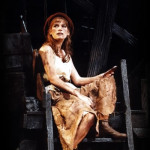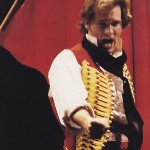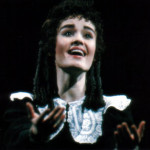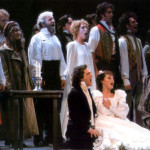Marius
As with Valjean and Fantine, it’s easy to assume that the screen portrayal of Marius can’t possibly be equaled. Eddie Redmayne gives a consummate performance that combines romance and tenderness with strength, passion and dignity, not to mention a rich, handsome voice, and has probably made countless Les Mis fans fall in love with a character they once viewed as a boring, stereotypical lover boy. Furthermore, the screenplay enriches Marius’s role with more heroic revolutionary action and details from the novel that the stage version leaves out, namely his life of voluntary poverty and estrangement from the royalist grandfather who raised him. But I know from experience that any good young stage actor can give an outstanding performance in the role, likewise avoiding the trap of “boring, stereotypical lover boy,” yet without copying Redmayne at all and without needing the screenplay’s role-enhancement to be effective.
Nearly every stage Marius I’ve seen has made the character seem slightly younger than Redmayne does, with supreme emphasis on his journey from boyhood to manhood. This journey is present in the film too, of course, but a more mature manner from the start is probably inevitable when a 30-year-old actor plays a student-aged character. While Redmayne’s Marius is a serious young man with a calmly intelligent air, who seems to be one of Enjolras’s right-hand men in the uprising and who relates to him more or less as an equal, a more typical stage Marius is characterized by naiveté and by boyish cheerfulness and energy (yet still with the dignity of his social class), clearly a “little brother” figure to Enjolras and the rest of the revolutionaries. Such a Marius would very believably be overwhelmed by his love for Cosette to the point that it distracts him from the uprising and believably be oblivious to Éponine’s love. Not that Redmayne doesn’t make those things fully convincing, but an extra dose of youthfulness creates an even greater sense of “no wonder” – and perhaps it earns more sympathy for his dilemma of “love vs. the cause,” whereas the screen Marius arguably seems a bit more selfish and irresponsible when he nearly abandons the uprising despite apparently being a longtime, high-ranking lieutenant. Yet such a Marius can still be just as courageous as his screen counterpart, if less in the forefront of the battles, fueled by instinctive compassion for the poor and desire for justice, and by the belief that the revolutionary cause is too righteous to possibly fail. The stage Marius is traditionally dressed more elegantly than Redmayne and no voluntary poverty or estranged relatives are ever mentioned, so it’s easy to assume that he’s never known deprivation, difficult choices or any real suffering until the barricades.
A younger, more naïve Marius can also be more socially awkward than the film character and bring a welcome touch of humor to the potentially insipid “A Heart Full of Love.” Of course Redmayne already does this with his adorably nervous stammering, but the effect is understated, as is right for the screen. Onstage it can be broader. In the standard staging, on “I’m doing everything all wrong!” Marius actually runs away from Cosette in terror and starts to climb back over the garden gate, but then stops and sheepishly turns back to her on “I do not even know your name.” More embarrassing still, some other productions have him fall off the gate at the beginning of the scene and land flat on the ground at Cosette’s feet. Touches like these not only bring life to the love story, but give the audience a much-needed smile before the near-relentless drama of Act II.
Marius’s coming-of-age journey obviously begins when he’s forced to choose whether to follow Cosette across the sea or stay and fight at the barricade. This is possibly the first difficult decision of his life and it’s a terrible one. But he ultimately decides that fighting for the good of all France matter more than his or Cosette’s personal happiness. Further psychological growth can come through his relationship with Éponine. While the film Marius seems fond of her but only vaguely so, a stage Marius and Éponine can easily establish a close and touching cross-class friendship, akin to the brother-like bond shared by Courfeyrac and little Gavroche in the film. When such is the case, the realization of her love for him in “A Little Fall of Rain” hits him like a lightning bolt, leaving him racked not only with grief at her death, but remorse for having unwittingly broken her heart. While Redmayne pulls himself together after only a few quiet tears, many a stage Marius has clung to her body, sobbing, and then sat in a stupor of anguish until forced to join the battle. Her death might also make him realize for the first time just how dangerous his circumstances are, and that victory isn’t certain, but that he and all his friends could die without achieving anything.
This realization can only be made worse by Grantaire’s biting cynicism in “Drink With Me,” which the film unfortunately cuts. Well I remember one Marius I saw in several stage performances, who was obviously deeply disturbed by Grantaire’s words, and afterwards sat and contemplated his own tricolor sash in misery, seemingly wondering if the drunkard was right, if the cause was pointless, and if he was sacrificing his life and a future with Cosette for nothing. As a result of this fear and anguish, such a Marius typically starts to show a grittier fighting spirit and less blind obedience to Enjolras. While in the film his offer to collect bullets in the street is a calm pre-battle conversation, onstage it’s an intense mid-combat moment and is often played as heated argument, as Enjolras refuses to let his friend risk his life but Marius refuses to back down.
A Marius who follows this path will arrive at “Empty Chairs at Empty Tables” as a broken shell of the exuberant idealist he once was. Redmayne’s outpouring of grief in the film is nothing less than heartrending, but a stage actor can take the song into even darker territory, expressing not just bleak despair but rage as well, conveying a sense that his idealism has died with his friends and that like Grantaire, he now believes in nothing. This bitterness can carry through to “Every Day”: some actors deliver “…who was it brought me here from the barricade?” angrily, as if Marius wishes he had died too and resents having been rescued. Thus the effect is all the more dramatic when Cosette’s tender reprise of “A Heart Full of Love” brings him back to life, gradually stirring his heart until finally his old smile reappears and all despair melts away as they reaffirm their devotion. Through the unopposed love and joy he shares at long last with Cosette, and through the subsequent revelation of Valjean’s heroism and achievements, we can infer that Marius’s hope for the world is restored. Whether by fighting at future barricades, by writing a Les Misérables-like novel (Hugo allegedly based Marius on his own younger self, after all), or just by living a noble, compassionate life like Valjean’s and teaching those values to his children, he will keep striving for justice and for the end of suffering, not with naïve idealism anymore, but with undying hope all the same.
I have hardly any complaints about Eddie Redmayne’s engaging, moving Marius, but a more boyish portrayal with a more obvious coming-of-age arc is one that I’ve seen and loved equally well. Both characterizations prove that there’s no reason for Marius to be a bland, shallow male ingénue. He has the full potential to be a multifaceted character whom the audience loves and is eager to follow.
Éponine
Here we have the audience’s darling. The character who more Les Mis lovers call their favorite than any other, whom every musical-loving teenage girl wants to play, and who is probably the stage version’s most iconic figure apart from Jean Valjean himself, because nearly everyone can relate to her plight of unrequited love. While in the film her role is slightly reduced and has received less media attention than those played by more famous performers, many still consider her, and her actress Samantha Barks, to be the highlight of the piece. Yet her portrayal in the musical often draws ire from Hugophiles, who complain that a dark, complex figure from the novel is prettified into a stock romance heroine. Their gripe is valid… but it needs not be fully true. A prettified, ingénueish characterization is indeed an easy path for an actress playing Éponine, and is more or less the way the film presents her, but it’s far from the only way to play her.
Hugo’s Éponine, while sympathetic, is a true street urchin: ugly, raspy-voiced, hardened, half-crazed and amoral. Obviously she can’t quite be played that way in the musical; the libretto innately idealizes her, omitting her morally questionable actions (the film actually brings one back – her keeping Cosette’s letter from Marius) and emphasizing her love for Marius at the expense of all else. But her “street rat” side needs not be downplayed. Just listen to Frances Ruffelle’s rugged, brassy vocals on the Original London and Broadway Cast Recordings, or look at Lea Salonga’s slouching posture, sullen expressions and tough-girl saunter in the 10th Ann. Concert! If the Thénardiers are portrayed as rougher articles than their screen incarnations, it only makes sense that their daughter be one too.
The most widely acclaimed stage Éponines, the ones praised by Hugophiles and ordinary theatregoers alike, have usually portrayed her as very tough, dirty, streetwise, and a real tomboy – unlike the film Éponine, whose looks and mannerisms, while ragged and lower-class, are still very feminine. In such a case, Marius’s blindness to her love doesn’t stem only from the class difference between them or from his naiveté, but from the fact that he barely considers her a girl! While in the film she first appears at the students’ rally, gazing at Marius, onstage she enters with her parents and the gang, and her first action is usually to elbow gang-member Montparnasse in the ribs when he gets fresh with her. Later, in “Attack on Rue Plumet,” she typically makes none of Barks’s attempts to gently reason with the men, but knows from the start that reasoning is impossible and fights them off with all the anger and ferocity that life in the slums can foster. (Even as a child she can be more aggressive than her film counterpart – onstage Young Éponine usually shoves Young Cosette out into the night to fetch the water, while onscreen the two little girls never interact.) This type of Éponine will interact differently with Marius too. In their film exchanges, her sassy veneer is delicate, barely concealing the shyness of, in Barks’s words, an “awkward, self-loathing teenager”; onstage she can be more forward, constantly striving for his attention with bravado. The classic staging of their first exchange has her snatch his book, make him chase her for it, and if she feels especially cheeky, give it back only to knock it from his hands onto the ground the moment his guard is down.
This brings me to the fact that onstage, Éponine can have something else she doesn’t quite have onscreen: a character arc. The film Éponine, though the letter incident makes her morally grayer than her stage counterpart, is essentially a static figure who seems to know from the start that Marius will probably never love her. Although she sings “Still I say there’s a way for us!” her feeble, tearful delivery of the line (what a contrast to Lea Salonga’s fierce, defiant delivery in the 10th Ann. Concert!) seems to imply that she doesn’t really believe it. She plays no part in Marius’s decision to fight at the barricade, nor does she make any attempt to be noticed by him when she joins him there. Her famous lament “On My Own” is placed in the middle of her role and she could probably have sung it at any point. But onstage, “On My Own” is her last scene before her death, and an actress can structure her whole performance to build toward that solo with the gradual realization that Marius will never be hers.
At first, whether out of naiveté or pure desperation, such an Éponine would truly believe that Marius might love her someday. Her constant bids for his attention would stem from that belief and from eagerness to fight for that goal the same way she fights to survive daily. Though she would briefly despair at the sight of his romantic idyll with Cosette, Valjean’s sudden resolve to take Cosette across the sea would restore her hope. Thus she would persuade Marius to join his friends at the barricade (during “One Day More” in the 1987 Tony Awards telecast, Frances Ruffelle pulls on his arm while singing “The time is now! The day is here!” with the chorus) and follow him into battle not just to “be with him,” nor to die with him as in the novel, but to prove her worth to him once and for all. Upon arriving at the barricade site she would purposefully get his attention by brushing against him or playfully punching his arm… only to be shattered when he asks her once again to be the go-between for him and Cosette. In “On My Own” she would finally be forced to admit that Marius’s love is unobtainable, and on a deeper level, that she’ll never escape from the gutter or know much happiness. Whether this realization should chiefly be sad or angry can be debated endlessly. Some Les Mis lovers swear that “On My Own” must be an angry song, while others insist it must be a sad song. Really it’s up to the actress. But either way, the stage version of the song is her role’s emotional climax and traditionally a blazing power ballad, very different from Barks’s delicate, vulnerable, crying-in-the-rain rendition.
A fierce, non-prettified portrait of Éponine might not appeal to all the people who adore Barks’s lovely, fragile waif, but it’s worth a try for a willing actress. If she’s portrayed as a hardened, gritty, endlessly determined street rat, then her pining for Marius just might become all the more poignant, because it would come from someone who decidedly isn’t a stock romance heroine.
Enjolras
The casting of Aaron Tveit in the role of the ardent revolutionary leader is a choice that you’d think would overjoy all theatre fans: a beloved young actor of stage and TV with outstanding charisma and Broadway-caliber vocal chops. Why, then, did cries of “weak,” “bland,” “not leader material” and (from the less mature) “He sucks!” resound everywhere the moment some of his singing from the film was leaked online? Why is his performance still controversial in some circles? The answer, in my humble opinion, has nothing to do with his level of talent. It’s just that visually, vocally and dramatically, his Enjolras is completely different from the characterization most often seen and heard onstage.
The Enjolras presented by Tveit and the filmmakers attempts to hew close to Hugo’s original characterization… though ironically, some Les Mis fans feel that he comes across as the opposite of Hugo’s character. Like the novel’s Enjolras, he looks very youthful, with an innocent, “angelic” type of beauty. His silky tenor is likewise boyish and not hugely powerful, but still stirring with its bright, creamy purity. And his characterization is built around quiet dignity and quietly smoldering revolutionary fervor. His demeanor is solemn and stern yet gentle, his body language is restrained, he never raises his voice except to be heard through the chaos of battle, and while he’s unquestionably a fierce warrior who lives and breathes the cause and defies the enemy to the end, he completely lacks the machismo that’s usually associated with such a fighting spirit. In him we see the young man whom Hugo describes as having “menacing majesty” yet at the same time likens to a flower. Why do some people call him “the opposite of Hugo’s Enjolras,” then? I think because Hugo’s Enjolras is a highly symbolic character, described in terms of marble, angels and mythical heroes. It’s difficult for any actor, especially a young, boyish-faced actor, to capture the ethereal, awe-inspiring nature of Hugo’s Enjolras, or to fully embody his “menacing majesty” while still retaining his quiet dignity and youthfulness. From the moment Tveit and the filmmakers decided to highlight those last qualities, cries from Hugophiles of “too human” and “too vulnerable” were probably inevitable.
But whether we view Tveit’s Enjolras as true to Hugo’s vision or the opposite, a typical stage Enjolras is very different. His physical presence is usually more commanding, with “manlier” looks to contrast with the boyish Marius: older, taller and more muscular than his friend. To match his looks, he usually has a powerhouse voice such as Michael Maguire’s trumpeting baritone, Ramin Karimloo’s piercing tenor or Anthony Warlow’s operatic tones, in contrast to Marius’s lighter pop tenor. (It’s no surprise that Marius, not Enjolras, was the role Tveit first auditioned for.) And in the best stage performances, the “menacing majesty” that Tveit conveys through his face alone instead radiates from the character’s whole body, every movement conveying passion for the cause and a leader’s authority. This rabble-rouser leaps onto chairs and tables to deliver his speeches, frequently shouts words for emphasis rather than singing them, and thrills the audience in “One Day More” as he runs to center-stage, wielding a rifle above his head and belting his battle cry for all to hear. While a quietly inspiring, angel-like youth might work as an embodiment of revolution on the printed page and in the intimacy of film, onstage we arguably need more of a firebrand.
This isn’t to say that a stage Enjolras should learn nothing from Tveit. I can’t underemphasize the value of stately dignity in the role, of being able to command attention with only a glance or gesture, and of idealism, not rage or machismo, being the character’s defining quality. Overly angry, aggressive portrayals of Enjolras are a common pet peeve among Les Mis lovers. (They even have nicknames for that type: “G.I. Jolras” or “Hunjolras.”) But still, a portrayal exactly like Tveit’s might make the character seem like a lost little boy onstage, or at least underwhelm the audience. While a typical stage Enjolras might lack the “flower-like” aspect of Hugo’s character, he has the heroic, awe-inspiring fervor in spades.
A stage Enjolras might also want to develop his relationships with the other revolutionaries further than they’re developed in the film. Tveit’s Enjolras is a figure absorbed in his ideals (once again, true to Hugo’s conception), and while he clearly loves his friends, especially Marius, he always seems slightly aloof from them. But a stage portrayal of the character only deepens if the actor lets himself be just a shade warmer and come across as a more intimate friend to his followers. If Marius is played younger and more naïve than his screen counterpart, then it’s only natural that Enjolras be more of an older brother figure to him: one who can be stern, as when he chastises him in “Red and Black” and when he forbids him to go collect bullets, but also extremely caring, which he usually shows by comforting him after Éponine dies, and later by running to his side when he’s shot and expressing brief anguish at his apparent death before charging toward his own fate. And one thing that endears any Enjolras to diehard Les Mis lovers is a vividly realized rapport with Grantaire based on the novel, in which he initially despises the drunkard (“Grantaire, put the bottle down!”) but ultimately comes to appreciate his loyalty. The stage version lacks their shared death by firing squad, but a similar reconciliation often comes after Grantaire’s solo in “Drink With Me;” at that point Enjolras might approach him angrily, only for gazes and gestures to be exchanged that make the leader fully grasp the devotion behind his foil’s cynicism. In many performances, this silent moment goes so far as to end with a hug between them at center stage. (Or, alternately, the “Drink With Me” moment can be a total angry rejection on Enjolras’s part, and their reconciliation can come in the Final Battle, in their joint grief over Marius’s “dead” body – I’ve seen it done both ways.)
Another silent moment that a stage Enjolras can make his own is the moment after Gavroche’s death. While onscreen, the moment emphasizes the distraught Courfeyrac and the horrified army officer, the traditional staging emphasizes Enjolras, who stands at the center of the barricade gazing out at the audience. Some actors offer a numb stare, others a look of abject anguish, and some even a few tears. But then his grief turns to rage. The stage version of “Let us die facing our foes…” is frantically orchestrated, as opposed to the drawn-out, nearly a capella film version, and rather than Tveit’s slowly building fervor, a stage Enjolras traditionally sings all his final words with scorching defiance.
Again, I’m not encouraging any stage actor to be “G.I. Jolras” or completely discard Tveit’s quiet dignity. My point is just that the stage character is traditionally very different from the film character, and maybe rightfully so. Ultimately, all that matters is that the audience admire Enjolras, understand why his friends follow him to their deaths, and possibly even feel that they would do the same.
Cosette
At last we come to the character who ties the whole story together – the lovely young girl who transforms lives, inspires tremendous sacrifices and ultimately personifies Hugo’s message of hope. It’s not without reason that her childhood face serves as the logo for the musical. Yet of all the principle characters, none has been more irrationally hated over the years. “Boring,” “weak,” “prissy,” “spoiled,” “airhead,” “icky-gooey,” “shallow,” “annoying”… these are all terms typically used to describe her by fans of the show!
Why such venom toward a sweet, innocent person who never does anyone any harm? Obviously some, probably most of it comes from people who adore Éponine and despise Cosette for “stealing” Marius from her. But beyond that, her problem is simply her status as a stock ingénue in a drama where nearly everyone has greater displays of depth, suffering and strength. Compared to the others, it’s easy to view her as a bland, syrupy romantic stereotype. And I’m afraid the film does less to combat this view than it could have done. I don’t mean this as a slight on Amanda Seyfried; she’s an excellent actress who infuses the role with warmth, charm and feeling. Nor am I accusing Tom Hooper of slighting the character. His DVD commentary makes it clear that he recognized her importance and worth. Still, her screen characterization places its emphasis on sweet, gentle innocence, not on liveliness, passion, or inner strength. For the most part she remains an old-fashioned ingénue. But onstage, different choices can be made.
Instead of the quiet, mild-mannered convent-school girl of the film, the stage Cosette can easily be more akin to Seyfried’s exuberant, spunky character of Sophie from Mamma Mia! (albeit with 1830s bourgeois refinement). Hugo himself described her as “rather a lark than a dove” and as “wild and brave at heart.” In the right hands, her solo verse of “In My Life” can express not just a starry-eyed ingénue’s romantic reverie, but a dignified yet vivacious young woman’s ardent longing to embrace love, adulthood, and the world beyond the gilded cage in which she lives. Casting a rich, sparkling soprano voice in the role as opposed to Seyfried’s light, wispy vocals (see “Singing style”) can only enhance this impression. It’s a mistake to assume that her innocence equals stupidity: after all, when Valjean nearly discovers Marius and Éponine hiding outside the garden gate (a moment cut from the film), she protects them by improvising a convincing story on the spot! Nor should we assume that her femininity equals weakness. Growing up to be a cheerful, loving person after a childhood as horrific as hers was arguably shows just as much strength as Éponine’s more overt feistiness.
Not that Cosette can’t have a trace of overt feistiness as well… her emerging womanhood needs not be expressed only by blossoming beauty and new longings, but can also be conveyed by that classic sign of growing up, teenage rebellion. Seyfried’s firm yet gentle delivery of “In my life, I’m no longer a child and I yearn for the truth that you know…” works perfectly well, but no stage actress should be afraid to bring more passionate yearning to that line, as well as more frustration and even anger at being cut off from the world without knowing why. Though of course she needs to be careful not to cross the line into “spoiled brat.” We should have no doubt that she loves Valjean and is grateful to him. If well staged, their interactions in “One Day More” can touchingly sum up their whole relationship. At the beginning, for example, she might bitterly pull away from his consoling hand and run off to sing with Marius, but later, when he brings out her old doll, she can cradle it tenderly, her anger and hurt dissolving as she remembers all the love and care her father has given her, and then turn and clasp him in her arms.
The best thing any actress can bring to Cosette is a real effort to make her a human being, not just a “lady.” Rather than showing instant happiness and ease in “A Heart Full of Love” the best stage Cosettes in my experience have made her just as adorably terrified and awkward as Marius at the beginning. In the traditional staging, when Marius starts to run away (see “Marius”), Cosette typically starts to run after him, then whirls around in embarrassment the moment he looks back at her, but then slowly, shyly turns to face him again on “…no fear, no regret.” And probably the best way to dispel any sense of her being “prissy” or “spoiled” is for her to show clear sympathy for those less fortunate than she is. It’s really too bad that Seyfried never gets to interact with the Thénardiers or Éponine! How effective it is onstage in “The Robbery” to see Cosette kneel down to console the sobbing “beggar woman,” full of compassion, only to leap back in shock and confusion upon recognizing her as Mme. Thénardier! Or near the end of “Attack on Rue Plumet,” to see her curtsey to Éponine, showing her utmost respect despite their class difference and uncomfortable past history!
Compassion and respect are also important for her to convey toward Marius in “Every Day.” Seyfried gets away with gently smiling through that scene only because at the same time she manages to express caring and tenderness. Onstage, without the camera’s intimacy to convey such subtleties, that approach can seem insensitive to Marius’s grief, especially on the line “Don’t think about it Marius” and especially if his despair is even darker and more embittered than it is onscreen. In the latter scenario, particularly, I think it’s best that she show deep distress at his pain, fairly beg him to remember their love and be happy again, and only smile again when he finally does.
Easy though it is to portray Cosette as a bland, syrupy romantic stereotype, doing so weakens the message of hope she personifies. Advertisements for the musical often speak of “the triumph of the human spirit” as one of its main themes, but what “triumph of the human spirit” does Les Misérables show us anyway? It certainly isn’t just the fact that all the characters who die go to heaven (if it were, then why is the story beloved among people of all religions and even atheists?), or just that Valjean redeems himself and lives a good, noble life. Isn’t it equally important that the sacrifices of Valjean, Fantine and Éponine pay off, that Marius and Cosette are saved, and that in the end, the once-tragic little Cosette is a radiant young woman with a future full of love and hope lying before her? For us to see that achievement as the triumph it is, Cosette needs to be a person to care about: a relatable human being, full of just as much warmth and life as the people whose sacrifices ensure her happiness.
Ensemble
Even the supporting roles in this musical are open to interpretation, and as with the principles, their film incarnations often seem like different people than the characters we usually see onstage. Take Gavroche, for example. While I certainly don’t know of anyone who dislikes Daniel Huttlestone’s performance, his laid-back, naturalistic characterization probably works best on film; onstage I suspect we need more of the traditional “Artful Dodger”-style cheek and brashness, as we see in Adam Searles and Robert Madge in the anniversary concerts. (Though of course it shouldn’t be overplayed, lest the audience want to shoot him themselves!) Likewise, the understated “smug snake” demeanors of Michael Jibson’s factory foreman and Bertie Carvel’s Bamatabois work well onscreen but might be too subtle for the stage, where both characters are usually imposing sexual predators: the foreman rugged and working-class, Bamatabois with pretensions of dignity, but both fearsome. Meanwhile, the factory girl who reveals Fantine’s secret isn’t traditionally the plain, seemingly respectable yet subtly nasty woman played by Kate Fleetwood onscreen, but a beautiful and catty “queen bee” type, usually portrayed as the foreman’s mistress who ruins Fantine out of jealousy.
Then, of course, there’s Grantaire, a character whose popularity with the fandom far exceeds his page, stage and screen time. Rather than the well-dressed “gentleman” drunkard whom George Blagden plays onscreen, a typical stage Grantaire sports long hair, an unshaven face and slovenly clothes, sings with a gruff-edged baritone (like Aaron Tveit, the sweet-voiced Blagden originally auditioned for Marius; a stage Grantaire traditionally understudies Javert) and is generally wilder and bawdier. His teasing of Marius often includes a smacking kiss on the cheek and almost always includes a fake erection using a rolled-up newspaper or wine bottle on “…”Don Juan!” Yet when eyes aren’t on him, we see what lies behind it all; the melancholy, bitterness, self-loathing, nihilism, and lack of any faith or ideals, which drives him to drink and is eventually voiced in his solo in “Drink With Me.” Yet as in the film, he stays at the barricade and dies out of devotion to Enjolras, whom he venerates precisely because Enjolras embodies the faith and idealism that he himself lacks. In the right actor and stage director’s hands, the complex feelings he projects toward Enjolras in the novel (surface mockery and frustration combined with staunch loyalty, flashes of tenderness and yearning for acceptance) can be portrayed clearly and compellingly; not on the sidelines the way they are through most of the film. Nor should any actor shy away from implying, as Blagden subtly does onscreen, that his devotion is romantic: a homoerotic vibe was almost certainly intended by Hugo. Another typical difference between stage and screen is that the close friendship with Gavroche and abject grief at his death that belong to Courfeyrac in the film usually belong to Grantaire onstage.
Without question the film ensemble offers excellent, vivid work, but a widespread complaint from stage fans is that Hooper and co. gave them the short shrift, cutting scads of their material and giving them all-too-little camera focus. But onstage there is no camera. The audience can focus on any ensemble members they like at any time and in the best performances I’ve seen, every performer in every scene brings his or her character to life, no matter how minor. Scene stealing can happen when it’s least expected. For example, the character of Montparnasse, at whom the film barely glances, can be a memorable cameo onstage with a characterization drawn from the novel – a handsome, knife-wielding teenage dandy who has an implied sexual history with Éponine. Nor do the revolutionaries other than Marius Enjolras and Grantaire need to be interchangeable, but can subtly infuse their stage time with the vivid, endearing personalities Hugo gave them: peace-loving, intellectual Combeferre, gentle yet intrepid Romantic poet Jean Prouvaire, idealistic working-class orphan Feuilly, lively and witty “heart of the group” Courfeyrac, cheerfully unlucky Lesgles, cheerfully neurotic Joly, and worldly, hot-blooded Bahorel (though the stage libretto doesn’t mention him by name, an ensemble member can still play him). No matter how small the role, every performer has room to make it his or her own.
I’ve said it once and I’ll say it again: I love the film version of Les Misérables. The point of this essay isn’t to criticize it or to claim that the characters “should” be portrayed differently onstage. Its purpose is just to compare and contrast the film with stage tradition and to point out that certain alternate characterizations might be more effective onstage because film and live theatre are two different genres. Above all, its purpose is to encourage actors, directors, et al, to explore the depths of the musical and put their own stamp on it. The cast of a stage production needs feel no more tied to the characterizations onscreen than the film cast did to the standard stage characterizations. The film is only one interpretation of Boublil, Schönberg and Kretzmer’s theatrical tour-de-force, which in turn is just one interpretation of Victor Hugo’s literary masterpiece. Ideally, every performance of Les Misérables should be a new interpretation, moving and exhilarating in fresh, unique ways.














Anne Rappe
August 17th, 2014 at 03:01
I really enjoy this analysis of Les Miserables. I have sadly never seen the play, but enjoyed the new movie. However, I do enjoy theater and miss it. It is a very interesting blog!!